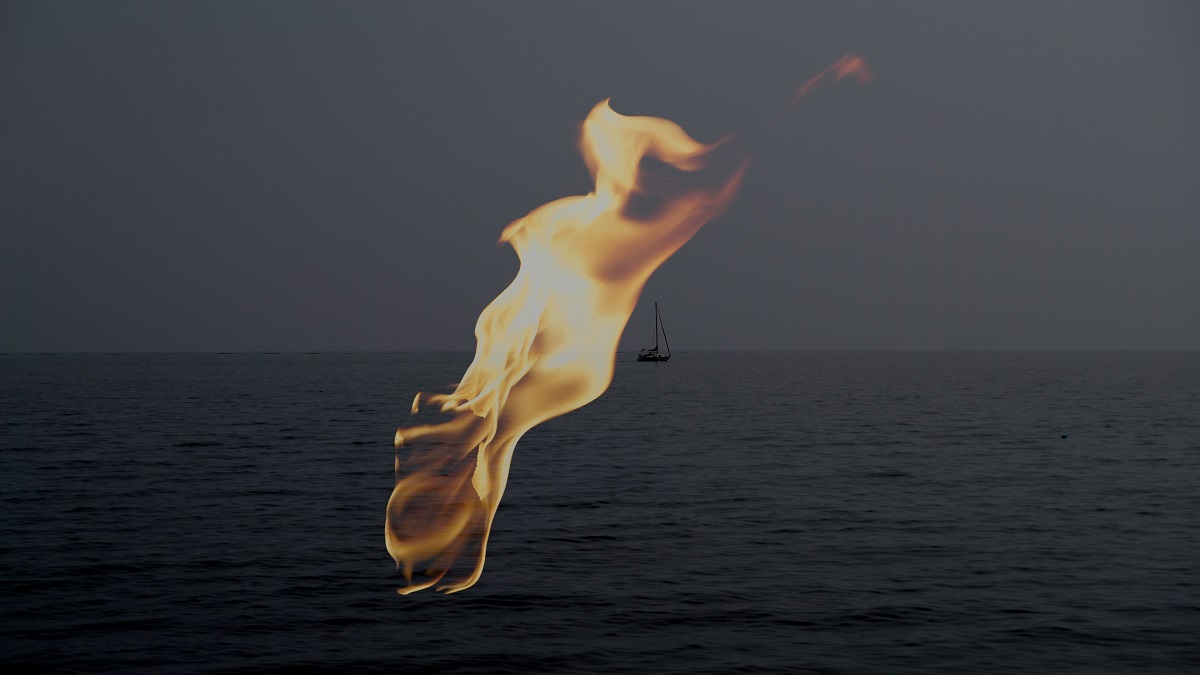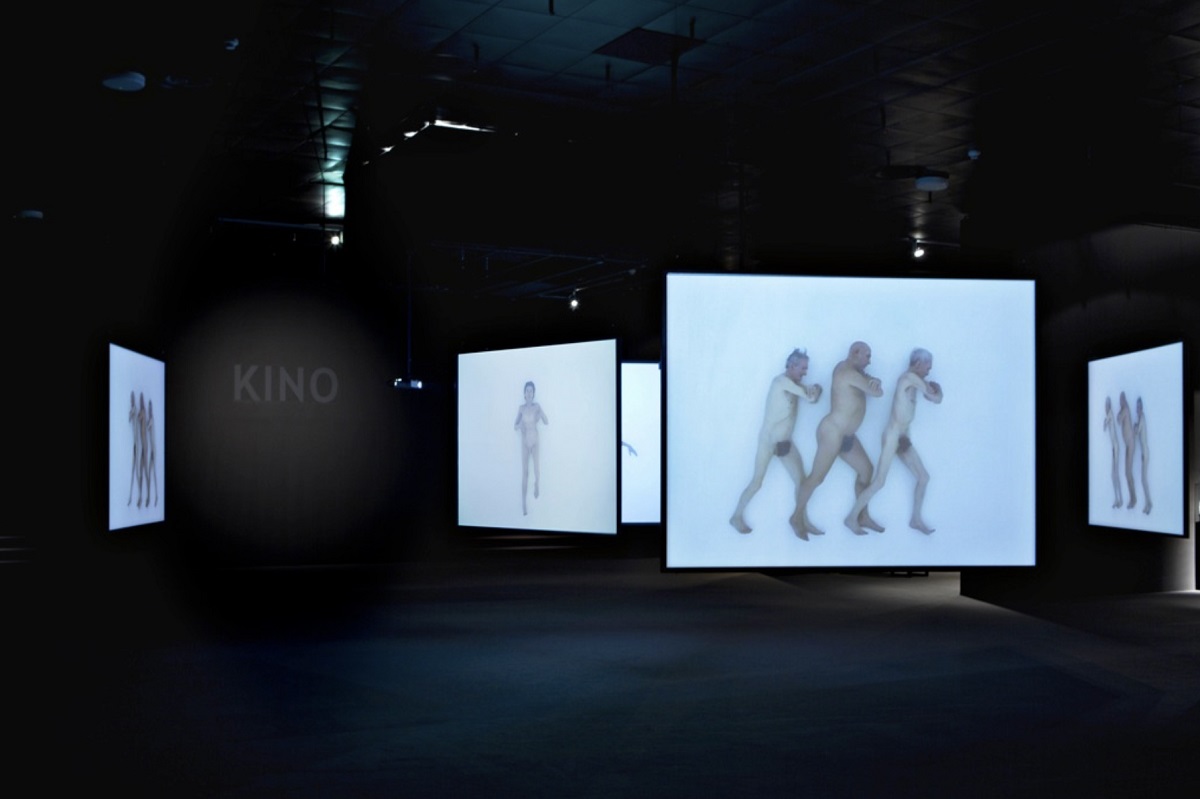AR、VR、互動、沉浸式為近年影像創作趨勢,但是本屆台灣國際錄像藝術展卻不見這些熱門字眼,標榜回歸以原始的方式觀看影像。策展人林怡華和游崴挑選意象式或概念性強作品,邀請觀眾以放鬆的姿態前來「體驗」影像。
展出作品之一,賽爾.弗洛伊(Ceal FLOYER)《雙幕》(Double Act),是一個簡單的靜態投影,但這個投影卻具有將空間轉變成劇場的魔力。一盞PAR燈打在紅布上的影像,讓人感覺像身處劇場,正等待開演。林怡華說,「某種程度上,那個光影會造成物理性的幻覺,一種像似視覺的觸感,霎時改變了場所的功能或情境,但實際上就只是一盞燈,卻創造了幻覺的真實性。」作品以單純的手法創造影像的魔幻性,觀者像是被催眠般感覺自己所處環境改變了,或許大腦還會連結到某次看戲的經驗感受。
「一切跟在腦中成像的速率有關。即便是觀看靜止的影像,卻可以很快入戲。」林怡華所說的「入戲」,不是指劇情方面的入戲,而是因為對影像有感以至於看得很「進去」。於是展覽提出「催眠作為一種觀影儀式」,這並不是說要替觀眾實施催眠術,也不是要討論催眠原理、心理學研究;而是形容當人深受影像吸引,看到出神的那種狀態,就像是被影像給催眠了,然後在這個過程中,腦中若似無地感受到其他影像浮現,引導著你的感覺和思考。不管那是潛意識、記憶連結、幻覺或其他,這既存在也不存在,無法測量的影像,才是策展人所強調的影像性與觀看的方法。主題「ANIMA」(發音如「阿尼瑪」),意指生命或靈魂,展覽以此指涉那個腦袋生成的影像,宛如「影像靈魂」。游崴指出,「靈魂作為一個寬鬆的比喻,指的是那些縈繞在影像之中無法明確表述的東西」。
這個ANIMA、靈魂,實在很難被文字語言描述,只能用感覺的。簡單來說,這次來看錄像藝術展,請暫時卸下用理性邏輯分析、用眼睛閱讀消化影像的習慣,用體驗的,任感覺到的影像牽引你出神、入戲。
 小泉明郎的作品《失憶狀態》(In the State of Amnesia)。圖/小泉明郎、Annet Gelink Gallery (Amsterdam)、Mujin-to Production (Tokyo) 提供
小泉明郎的作品《失憶狀態》(In the State of Amnesia)。圖/小泉明郎、Annet Gelink Gallery (Amsterdam)、Mujin-to Production (Tokyo) 提供
李基宏在開展前至展期結束,總共90天的日子,每天在固定時間來到C-LAB美援大樓,以手機光源照射牆面,並用攝影機錄下這個行為,再將此影像投射在現場。他每日重複這個過程,所拍攝的影像也會重複堆疊投影在牆面,這個「被堆疊的光」也將愈來愈亮。《微光》結合觀念行為、影像和光學,創作過程就像是堆疊了光的影像靈魂。
樹懶是世界上動作最慢的哺乳類動物,班.瑞佛斯(Ben RIVERS)《現在,終於!》(Now, at Last!),拍攝一隻樹懶的生活,固定的中距離鏡頭讓觀眾清楚看見樹懶在樹上的移動――極其緩慢的,牠好像睡著了,還是只是靜止不動呢?作品在東京展出時,許多觀眾坐在懶骨頭上看著看著也跟著睡著了,使得影像畫面和展覽現場互為表裡,好像觀眾的時間和影像中樹懶的時間同步了,不知道樹懶會不會現身在觀眾的睡夢中呢?這次在C-LAB展出現場也備有懶骨頭,讓大家放鬆試著變成樹懶,同步入眠。
除了夢境,人的記憶也經常以影像的方式顯現。小泉明郎《失憶狀態》(In the State of Amnesia)拍攝一名因腦部受傷導致記憶障礙的男子,他面對鏡頭陳述一個之前真實發生過的事件;隨著他的講述,話語愈來愈模糊不清,這個記憶似乎漸漸消散了,最後他也不記得自己說了什麼。沒有失憶的人,記憶亦會消散,那麼一個失憶狀態的記憶又是什麼形象?
劉玗混合影像、聲音、燈光與空間裝置,作品《真實一般的清晰可見》透過各種指引、提示與斷裂的敘事,引導觀眾在不依賴視覺條件的情況下,看見由個人意識所生成的圖像,感受「物理的觀看」與「意識的觀看」之間的影像流轉。既然展覽思考的是腦海中、感知裡無法具象化的影像,「ANIMA阿尼瑪」請來藝文工作者許家峰體驗這場展覽,身為視障者的他會如何評論這場展覽?展期內他將進行四個導覽場次,分享非視覺的觀點,帶領觀眾感受作品。
 卡塔茲娜.科茲拉(Katarzyna KOZYRA)的作品《春之祭》(The Rite of Spring)。圖/卡塔茲娜.科茲拉提供
卡塔茲娜.科茲拉(Katarzyna KOZYRA)的作品《春之祭》(The Rite of Spring)。圖/卡塔茲娜.科茲拉提供
另一件試圖擾動觀眾情緒和身體感知的作品,卡塔茲娜.科茲拉(Katarzyna KOZYRA)《春之祭》(The Rite of Spring)。這首史特拉汶斯基知名的芭雷舞交響樂,這次由年長者裸體演出,作品以七個大屏幕呈現多位年長者的裸體舞動。原本故事中獻祭的少女變成老化的皮囊,隨著《春之祭》不和諧、尖銳、與優美無關的樂音舞動身體,透過定格攝影手法拍攝,使得他們的肢體像機械故障般卡卡不流暢,畫面顯得詭異而不太真實。本次展出多為非敘事、如夢似真般的影像創作,游崴以「日常感的不尋常」形容它們共有的質地。
「ANIMA阿尼瑪」不以高科技或華麗的互動式影像來吸引目光,也不打算回應何謂錄像、何謂影像的定義問題。台灣國際錄像藝術展今年是第七屆,回顧每一屆內容皆涉及關於影像的詮釋;隨時代演進,錄像的類型定義愈來愈廣,從早期的單屏幕,到涵納紀錄片,爾後每一屆都在擴增定義。然而相較於發展論述回應類型史,「ANIMA阿尼瑪」的兩位策展人對「觀看者如何進入影像」更感興趣。在這個影像創作手法、媒材愈發複雜的年代,一方面人們喜歡複雜聲光效果的影像刺激感官,另一方面影像敘事開始講究調查研究,承載龐雜的資料量需要消化吸收;而本展選擇將觀點拉回單純的觀看。
展覽將在鳳甲美術館和C-LAB雙地點展出,這也是台灣國際錄像藝術展第一次走出鳳甲美術館。C-LAB以美援大樓為展覽空間,試著將空間氛圍貼合每件作品的影像風格,透過陳列和動線規畫讓看展更能沉浸其中。展覽中有六部偏向敘事型的作品,將自12月8日起在C-LAB中正堂的放映單元中呈現。9月引發首波騷動是六小時俄國電影《DAU:退變》,9月27日於中正堂進行臺灣首映,索票秒殺,瞬間哀鴻遍野。這場做為展覽放映計畫的開端,是本次「ANIMA阿尼瑪」與紀錄片影音平台「Giloo紀實影音」的合作企畫之一,除了本片,還將在Giloo平台上推出線上影展特別專題,從展覽主題的視角,呈現十部帶有日常魔幻感的紀實影片,作為實體展覽的延伸。
「ANIMA阿尼瑪」的看展方式,包含線上觀看、中正堂實體放映,有美援大樓這個替代空間,也有鳳甲美術館展場,試著為每一件作品找到最合適的觀看距離。雖然沒有時下流行的平板和穿戴式裝置,然而「ANIMA阿尼瑪」所提出被影像催眠般的出神狀態,作品的氛圍和原始直觀影像靈魂的觀影方式,其實是以另一種素樸的角度回應當代的「沉浸式」與「虛擬實境」。展覽自10月16日一路跨越至隔年,並規畫一系列論壇、導覽活動,請錄像迷們帶著「鬆散的注意力」前來體驗影像。